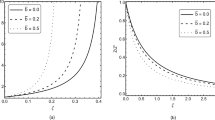Abstract
The creep tide theory is used to establish the basic equations of the tidal evolution of differentiated bodies formed by aligned homogeneous layers in co-rotation. The mass concentration of the body is given by the fluid Love number \(k_f\). The formulas are given by series expansions valid for high eccentricity systems. They are equivalent to Darwin’s equations, but formally more compact. An application to the case of Enceladus, with \(k_f=0.942\), is discussed.
Similar content being viewed by others
Notes
No hypothesis is done concerning the relative size of the two bodies. We may apply the given theory to any of the bodies of a 2-body system.
References
Beuthe, M., Rivoldini, A., Trinh, A.: Enceladus’s and Dione’s floating ice shells supported by minimum stress isostasy. Geophys. Res. Lett. 43, 10–088 (2016)
Bouvier, J., Forestini, M., Allain, S.: The angular momentum evolution of low-mass stars. Astron. Astrophys. 326, 1023–1043 (1997)
Cayley, A.: Tables of developments of functions in the theory of elliptic motion. Mem. Roy. Astron. Soc. 29, 191–306 (1861)
Darwin, G.H.: On the bodily tides of viscous and semi-elastic spheroids and on the ocean tides upon a yielding nucleus. Philos. Trans. 170, 1–35 (1879). (repr. Scientific Papers Vol. II, Cambridge, 1908)
Darwin, G.H.: On the secular change in the elements of the orbit of a satellite revolving about a tidally distorted planet. Philos. Trans. 171, 713–891 (1880a). (repr. Scientific Papers Vol. II, Cambridge, 1908)
Darwin, G.H.: On the analytical expressions which give the history of a fluid planet of small viscosity, attended by a single satellite. Proc. R. Soc. Lond. 30, 255–278 (1880b). (repr. Scientific Papers Vol. II, Cambridge, 1908)
Efroimsky, M.: Tidal evolution of asteroidal binaries. Ruled by viscosity. Ignorant of rigidity. Astron. J. 150, 98 (2015)
Efroimsky, M.: Tidal viscosity of Enceladus. Icarus 300, 223–226 (2018a)
Efroimsky, M.: Dissipation in a tidally perturbed body librating in longitude. Icarus 306, 328–354 (2018b)
Efroimsky, M., Williams, J.G.: Tidal torques I. A critical review of some techniques. Celest. Mech. Dyn. Astron. 104, 257–289 (2009)
Ferraz-Mello, S.: Tidal synchronization of close-in satellites and exoplanets. A rheophysical approach. Celest. Mech. Dyn. Astr. 116, 109–140 (2013). arXiv:1204.3957
Ferraz-Mello, S.: Tidal synchronization of close-in satellites and exoplanets: II. Spin dynamics and extension to Mercury and exoplanets host stars. Celest. Mech. Dyn. Astr. 122, 359–389 (2015). arXiv:1505.05384. Errata: Celest. Mech. Dyn. Astr. 130, 78, pp. 20–21 (2018)
Ferraz-Mello, S.: On tides and exoplanets. In: Proc. IAU Symp., vol 364 (in press) (2022)
Ferraz-Mello, S., Beaugé, C., Folonier, H.A., Gomes, G.O.: Tidal friction in satellites and planets. The new version of the creep tide theory. Eur. Phys. J. ST 229, 1441–1462 (2020)
Ferraz-Mello, S., Rodríguez, A., Hussmann, H.: Tidal friction in close-in satellites and exoplanets. The Darwin theory re-visited. Celest. Mech. Dyn. Astron. 101, 171–201 (2008). Errata: Celest. Mech. Dyn. Astr. 104, 319–320 (2009). (arXiv:0712.1156)
Folonier, H. A., Ferraz-Mello, S.: Tidal synchronization of an anelastic multi-layered satellite. Titan’s synchronous rotation. Celest. Mech. Dyn. Astron. 129, 359–396 (2017). arXiv:1706.08603
Folonier, H., Ferraz-Mello, S., Kholshevnikov, K.V.: The flattenings of the layers of rotating planets and satellites deformed by a tidal potential. Celest. Mech. Dyn. Astron. 122, 183–198 (online supplement) (2015). arXiv:1503.08051
Folonier, H.A., Ferraz-Mello, S., Andrade-Ines.E.:, Tidal synchronization of close-in satellites and exoplanets: III. Tidal dissipation revisited and application to Enceladus. Celest. Mech. Dyn. Astr. 130: 78 (2018). arXiv:1707.09229v2
Howett, C.J.A., Spencer, J.R., Pearl, J., Segura, M.: High heat flow from Enceladus’ south polar region measured using 10–600 cm\(^{-1}\) Cassini/CIRS data. J. Geophys. Res. Planets 116, id. E03003 (2011)
Iess, L., Stevenson, D.J., Parisi, M., Hemingway, D., Jacobson, R.A., et al.: The gravity field and interior structure of Enceladus. Science 344, 78–80 (2014)
Jeffreys, H.: The effect of tidal friction on eccentricity and inclination. Mon. Not. R. Astron. Soc. 122, 339–343 (1961)
Love, A.E.H.: The yielding of the Earth to disturbing forces. Proc. R. Soc. Lond. Ser. A 82, 73–88 (1909)
Nettelmann, N.: Tesseral harmonics of Jupiter from static tidal response. Astrophys. J. 874, 156 (2019)
Ragazzo, C.: The theory of figures of Clairaut with focus on the gravitational modulus: inequalities and an improvement in the Darwin–Radau equation. São Paulo J. Math. Sci. 14, 1–48 (2020)
Roberts, J.H., Nimmo, F.: Tidal heating and the long-term stability of a subsurface ocean on Enceladus. Icarus 194, 675–689 (2008)
Thomson, W.: On the rigidity of the Earth. Philos. Trans. R. Soc. Lond. 153, 573–582 (1863)
Wahl, S.M.: Modeling of Planetary Interiors: From Microscopic to Global Scales. University of California, Berkeley (2017)
Wahl, S.M., Hubbard, W.B., Militzer, B.: The concentric Maclaurin spheroid method with tides and a rotational enhancement of Saturn’s tidal response. Icarus 282, 183–194 (2017)
Acknowledgements
We thank the reviewers for their comments and suggestions. This investigation is sponsored by CNPq (Proc. 303540/2020-6) and FAPESP (Procs. 2016/13750-6 ref. PLATO mission, 2016/20189-9 and 2017/25224-0).
Author information
Authors and Affiliations
Corresponding author
Additional information
Publisher's Note
Springer Nature remains neutral with regard to jurisdictional claims in published maps and institutional affiliations.
Appendix: Equivalence of Darwin’s tidal theory for viscous bodies and the creep tide theory
Appendix: Equivalence of Darwin’s tidal theory for viscous bodies and the creep tide theory
In our previous papers, the equivalence of the variational equations derived from the creep tide theory and those of Darwin’s constant time lag (or CTL) theories was several times stressed. This equivalence is reinforced in this paper by the extension of the creep tide theory to a differentiated body with aligned co-rotating layers and the introduction of the actual fluid Love numbers.Footnote 3
The restriction to the CTL theories stems from the fact that all versions of Darwin’s theory published in the XX\(^{th}\) century (revisited in Ferraz-Mello et al. 2008) followed what was dubbed “Fall schwacher Reibung” by Gerstenkorn (1955), or “weak friction approximation” (Alexander 1973), in which the phase shifts, or lags, \(\sigma _k\) are assumed to be small quantities. This postulate introduces in the theories one stringent approximation: Darwin’s “height" (also called “fraction of equilibrium tide”) \(\cos \sigma _k\) becomes, in the first order of approximation, equal to 1 and disappears from the equations. When the factors \(\cos \sigma _k\) missing in the CTL theories are reintroduced, we have total equivalence of the creep tide theory and Darwin’s theory for homogeneous bodies.
The approach resulting from the introduction of the weak friction hypotheses was discussed by Efroimsky and Williams (2009) in a section of their paper, with the title “The stone rejected by the builders”. They showed that the weak friction approximation was the culprit for some apparent singularities appearing in the equations, near the synchronism of rotational and orbital motions, when the ad hoc lags were taken proportional to a negative power of the frequency.
In Darwin paper (1880a), the phase shifts are inserted by hand, both in the case where they are kept undetermined and in the cases where they are fixed in agreement with his 1879 paper. However, under no circumstances did he assume that the phase shifts are small. On the contrary, there are in his paper (Darwin 1880a) examples with phase shifts close to 45\(^{\circ }\) (the angles \(f, g, \dots \) adopted by him correspond to \(\frac{1}{2}\sigma _k\) in the creep tide theory). High phase shifts appear in the tidal deformation of bodies with very high viscosity (see examples in Ferraz-Mello et al. 2020).
Differences, however, exist between the two theories. The most obvious one is that the quantities playing the role of relaxation factor in these theories, \({\mathfrak {p}}\) and \(\gamma \), respectively, are related to the viscosity according to different laws (such that \(\gamma = 4.75 {\mathfrak {p}}\)). In addition, even in the case of viscous bodies, Darwin prefers to introduce the phase shifts by hand, while in the creep tide theory they are introduced through the (approximated) solution of the creep differential equation. Major differences, however, appear when we consider the parametric version of the creep tide theory (Folonier et al. 2018; Ferraz-Mello et al. 2020). These equations allow us to obtain a system of differential equations for the parameters defining the shape, orientation, and rotation of the body. The simultaneous integration of these equations can be done without the need for any hypotheses on the rotation of the deformed body.
Rights and permissions
About this article
Cite this article
Ferraz-Mello, S., Folonier, H.A. & Gomes, G.O. Creep tide theory: equations for differentiated bodies with aligned layers. Celest Mech Dyn Astron 134, 25 (2022). https://doi.org/10.1007/s10569-022-10082-8
Received:
Revised:
Accepted:
Published:
DOI: https://doi.org/10.1007/s10569-022-10082-8




